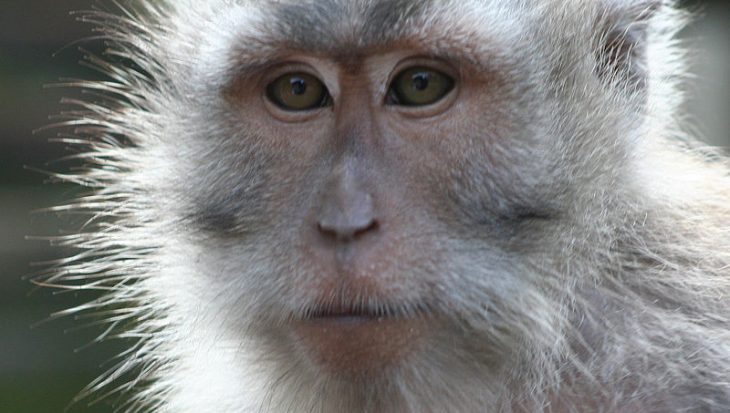Around twenty activists ranging from human and animal rights advocates to the anti arms trade contingent attended a demonstration against the Cheltenham Science Festival on Friday 8th June, amongst the protesters, representatives of Dr Claude Reiss PHD who is a top Parkinson’s researcher from France.
The police presence was very prominent (around 40 police officers). before the demonstration had started a few activists were followed and filmed by police whilst sitting in the town centre this included a young girl of around 6-7 years of age who wanted to hold the placard up and show people, she was then followed when she tried to leave by an officer with video camera at the dismay of her parents.
It was made clear from the outset that the demonstration was to focus on human science and medical facts as the case against research using animals and Tipu Aziz’s role in the development of DBS is solid scientifically. So no pictures of animals were displayed during the demonstration. Gloucestershire Animal Action focused on issues relating to the main festival sponsor Pfizer’s illegal clinical trials using third world children to test experimental drugs and the fact that millions are put into animal research whist hospitals are shutting due to NHS cutbacks.
Twelve tickets in total were purchased for Tipu Aziz’s talk and after much fuss the management decided they would let us in only after rigorous searching from police and security staff who took literally every item out and confiscated water, leaflets and various other items which presumably might cause a problem during the talk.
A representative of Dr Reiss PHD took to the stage just before the speakers entered the arena, the crowd looked on as she introduced herself on behalf of Dr Reiss whom couldn’t attend the festival, she then started to tell the crowd that we were there to oppose Aziz’s supposed role in the research and discovery of the Subthalamic Nucleus and the DBS technique, she had barely finished her sentence when she was literally picked up off the floor by a member of the private security and taken out of the building, not before asking members of the public to take a leaflet on the way out. One activist tried to intervene only to be told by an undercover police officer to “shut the f**k up”.
The talk started with Mary Baker from the Parkinson’s Disease Association introducing the other speakers Tipu Aziz and patient Mike Robins and Martin Westall who’s daughter can now walk thanks to deep brain stimulation.
Aziz took to the stage first and spoke for ten minutes without mentioning his research one bit, purely telling the audience how the technique works in humans. He was shortly followed by Mike Robins who referred to Aziz as a “god”. Martin Westall then took to the stage and gave a moving account of how his wife and daughter were given their lives back by DBS.
The hall was the handed over to the crowd for questions, Aziz was then unlucky enough to give the first question to an activist from Gloucestershire Animal Action who asked the following question:
“The Oxford Student, 21st Jan 2007, contained an article in which you state: “I was central to discovering the Subthalamic nucleus as a target for Deep Brain Stimulation”. However, according to neurosurgeon Dr Marius Maxwell, the first paper published on the role of the STN did not involve you at all, but Bergman, Wichmann, DeLong. Science 249 (4979) 1436-8,1990 Sep 21.
Here is what the author of our leaflet, Dr Claude Reiss, has to say about this area: “Although it is true that the application of Deep Brain Stimulation to the subthalamic nucleus has been suggested by experiments in MPTP monkeys, the application of Deep Brain Stimulation to PD sufferers was rapidly promoted following the discovery of the Benabid team, through human surgery. There is no doubt that the benefit of subthalamic nucleus stimulation would have been have been found without monkey experiments”.
At this point Mary Baker decided to interrupt. “Do you actually have a question??”. – She wasn’t rude enough to interrupt any non animal research related questions.
“Yes – Given all of the above, how can you justify the vast research grants which continue to divert funds towards monkeys, instead of human patients”?
And what was Tipu Aziz’s response to this question?
“Yes”
You don’t have to be a Neurosurgeon to realise that you cannot answer a question which starts “How” with the word “Yes”.
Activist: “Are you not going to answer my question?”
At this point Mary Baker tells the activist “I’m sure Professor Aziz will be glad to answer your question after the talk”.
The questions continue when a member of the audience not with the anti vivisection group asked “Is it really necessary to test on animals?” to which Aziz replies “Not in its entirety”… By now Aziz is looking nervous and on edge touching his face and moustache looking very uncomfortable.
More questions are asked by the audience regarding various other areas of DBS including its other applications and the cost (which is very high – maybe if research grants were available to researchers using human patients it might be more widely available and more cost effective).
The next question was asked by another member of the anti vivisection group and none of us expected what happened next.
“On the BBC’s recent documentary “Monkeys Rats and Me”, with reference to Felix, the macaque monkey, you said, and I quote: pain “is not part of the process of my research”. However Oxford University has disclosed that your research has been classified in the most severe category – substantial – which involves “significant morbidity”, a “major departure from the animals’ usual wellbeing”, and welfare that is “seriously compromised”, as defined by the Guidance on the Operation of the ASPA 1986. Can you explain this apparent contradiction and how do you respond to the charge that you are incapable of fulfilling…”
At this point a member of the Cheltenham Festival points at the activist mid question and police and security move towards him.
“…the duties of a licence holder because you are incapable of recognising the adverse effects suffered by Felix, and others, in your experiments.”
He finishes his question and is lifted to his feet by two security.
Tipu Aziz’ response was “I research Parkinson’s, not pain”.
The activist is then dragged from the hall he shouts “Fraud!” as he is manhandled. Outside he is asked for his name and address, he refuses point blank (he had not committed a crime and had no obligation to give his details.) he is then arrested and taken to Cheltenham Police station and charged with a “section 50” offence.
The questions are rounded off by Mary Baker and an activist attending his first demonstration attempts to ask a final question and is forcibly removed, the first activist asks Baker and Aziz, why they are physically having anyone removed who opposes their research. No comments. They are escorted from the room.
Outside, the crowd from the Aziz talk are taking leaflets and talking with activists about the shocking treatment of the individuals inside. A member of Gloucestershire Animal Action approaches the undercover police officer who told him to “shut the f*** up” with Dictaphone in pocket asks for his police number in order to make a complaint which he declines to give (this is illegal).
Friday was a fantastic day for the anti vivisection movement, which saw Tipu Aziz stumped by activists which no previous experience with debate or public speaking. It also proved the lengths at which the vivisection industry and its supporters are willing to go in order to prevent the public debate they say that we are incapable of engaging in.
Orwell from fiction to non fiction.
‘the best guess for the correlation of adverse reactions in man and animal toxicity data is somewhere between 5% and 25%’
Animal Toxicity Studies: Their Relevance to Man, Lumley and Walker (eds) (Quay, 1989), 57-67

